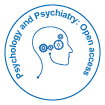The Role of Genetics and Environment in Autism Spectrum Disorders
Received: 01-Apr-2025 / Manuscript No. ppo-25-163429 / Editor assigned: 04-Apr-2025 / PreQC No. ppo-25-163429 (PQ) / Reviewed: 18-Apr-2025 / QC No. ppo-25-163429 / Revised: 22-Apr-2025 / Manuscript No. ppo-25-163429 (R) / Published Date: 30-Apr-2025 DOI: 10.4172/ppo.1000264
Abstract
Autism Spectrum Disorder (ASD) is a complex neurodevelopmental condition influenced by both genetic and environmental factors. Recent research has highlighted the interplay between genetic predisposition and environmental triggers in the development of ASD. Understanding the contributions of these factors is essential for early diagnosis, intervention, and treatment. This article explores the genetic and environmental influences on ASD, examining current research findings, potential risk factors, and future directions in ASD research. The discussion emphasizes the necessity of a multifactorial approach in understanding ASD etiology and improving support for affected individuals.
Keywords
Autism Spectrum Disorder; Genetics; Environmental factors; Neurodevelopmental disorders; Genetic predisposition; Epigenetics; Risk factors; Early intervention; Gene-environment interaction; Autism research
Introduction
Autism Spectrum Disorder (ASD) is characterized by persistent difficulties in social interaction, communication, and repetitive behaviors. The prevalence of ASD has increased over the years, with growing recognition of its heterogeneous nature. While early research focused primarily on genetic factors, recent studies have emphasized the significant role of environmental influences in ASD development. This article explores the complex relationship between genetics and environmental factors in ASD, highlighting their contributions, interactions, and implications for diagnosis and treatment.
Description
Genetic factors in ASD
Heritability of ASD- Studies estimate that genetic factors account for 50-80% of ASD risk.
Candidate genes- Several genes, such as SHANK3, FMR1, and CHD8, have been linked to ASD susceptibility.
Rare and common variants- Both rare genetic mutations and common polymorphisms contribute to ASD risk.
Epigenetic modifications- DNA methylation and histone modifications influence gene expression and may affect ASD development.
Genetic syndromes associated with ASD- Conditions like Fragile X Syndrome and Rett Syndrome show a strong genetic link to ASD.
Prenatal Factors- Maternal infections, exposure to toxins, and nutritional deficiencies during pregnancy may increase ASD risk.
Perinatal and neonatal influences- Complications during birth, such as hypoxia or low birth weight, may contribute to ASD.
Exposure to environmental toxins- Heavy metals, pesticides, and air pollution have been explored as potential risk factors.
Parental age- Advanced paternal and maternal age has been associated with a higher risk of ASD.
Gut microbiome and immune system interactions- Emerging research suggests gut microbiota may play a role in neurodevelopment and ASD symptoms.
Discussion on the role of genetics and environment in ASD
Gene-environment interaction- Genetic predisposition may increase susceptibility to environmental triggers, influencing ASD risk.
Twin studies- Research on monozygotic and dizygotic twins provides insights into the relative contributions of genes and environment.
Molecular pathways affected by environmental factors- Some environmental exposures may alter gene expression, leading to ASD-related traits.
Genetic screening and biomarkers- Early detection of genetic markers can improve ASD diagnosis and personalized treatment plans.
Neuroimaging and brain connectivity studies- Functional MRI and EEG provide insights into neural abnormalities in ASD.
Animal models and experimental research- Studies on animal models help researchers understand gene-environment interactions.
Early Behavioral and educational interventions- Strategies such as Applied Behavior Analysis (ABA) are effective in improving developmental outcomes.
Pharmacological treatments targeting genetic pathways- Emerging drugs focus on neurotransmitter imbalances linked to ASD.
Nutritional and environmental modifications- Adjusting diet and reducing exposure to potential environmental triggers may help manage ASD symptoms.
Genetic testing and counseling- Ethical concerns related to genetic screening for ASD risk.
Reducing stigma and promoting neurodiversity- Advocacy for acceptance and support of individuals with ASD.
Conclusion
Autism Spectrum Disorder is a complex condition influenced by a combination of genetic and environmental factors. Advances in genetics and neuroscience have improved our understanding of ASD etiology, highlighting the intricate gene-environment interactions that shape neurodevelopment. Continued research is necessary to refine diagnostic tools, develop targeted interventions, and provide better support for individuals with ASD and their families. Emphasizing a comprehensive, interdisciplinary approach will enhance early diagnosis and treatment, ultimately improving outcomes for those affected by ASD.
Acknowledgement
None
Conflict of Interest
None
References
- Van der Oord S, Tripp G (2020) Clinical child and family psychology review 23: 577-604.
- Kizilkaya AE, Sari H (2021) Asian Journal of Education and Training 7: 103-114.
- Parent J, McKee LG, N Rough J, Forehand R (2016) Journal of abnormal child psychology 44: 191-202.
- Slagt M, Deković M, de Haan AD, Van Den Akker AL, Prinzie P et al. (2012) Longitudinal associations between mothers' and fathers' sense of competence and children's externalizing problems: the mediating role of parenting. Developmental psychology 48: 1554.
- Roostaei M, Abedi S, Khazaeli K (2016) Journal of Research in Rehabilitation Sciences 11: 401-406.
- Sciberras E, Efron D, Patel P, Mulraney M, Lee KJ et al. (2019) BMC psychiatry 19: 1-9.
- Assari S, Caldwell CH (2019) Children 6: 10.
- Al-Yagon M, Lachmi M, Danino M (2020) Manual-based personalized intervention for mothers of children with sld/adhd: Effects on maternal and family resources and children’s internalizing/externalizing behaviors. Journal of Attention Disorders 24: 720-736.
- Efron D, Furley K, Gulenc A, Sciberras E (2018) Archives of disease in childhood 103: 841-846.
- Cortese S (2020) New England Journal of Medicine 383: 1050-1056.
, ,
,
, ,
, ,
, ,
, ,
, ,
, ,
, ,
, ,
Citation: John R (2025) The Role of Genetics and Environment in Autism Spectrum Disorders. Psychol Psychiatry 9: 264. DOI: 10.4172/ppo.1000264
Copyright: © 2025 John R. This is an open-access article distributed under the terms of the Creative Commons Attribution License, which permits unrestricted use, distribution, and reproduction in any medium, provided the original author and source are credited.
Share This Article
51ºÚÁϳԹÏÍø Journals
Article Tools
Article Usage
- Total views: 141
- [From(publication date): 0-0 - Apr 29, 2025]
- Breakdown by view type
- HTML page views: 96
- PDF downloads: 45
